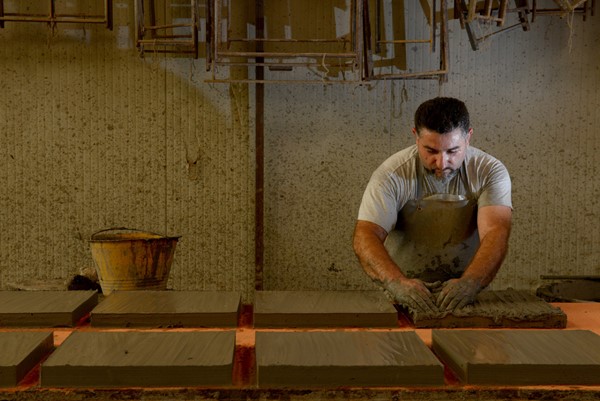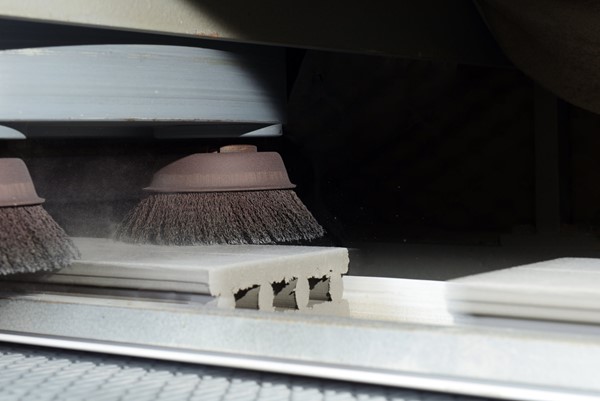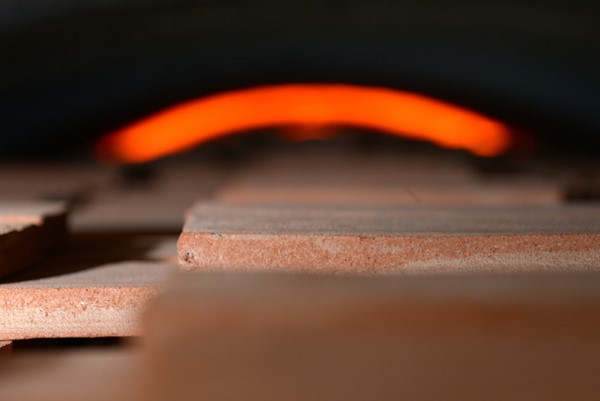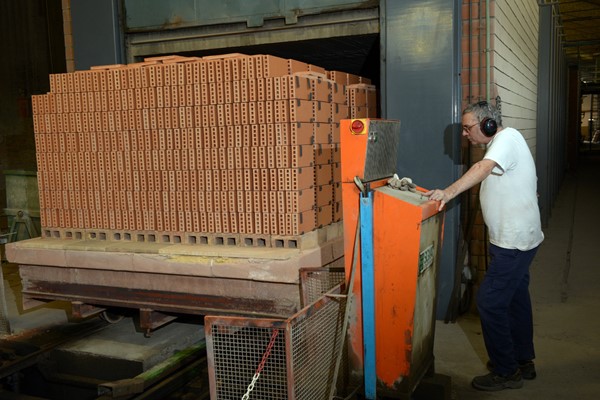Clay extraction and storage
The clay, extracted from the factory-owned quarries, undergoes a first selection as to possible impurities and contemporaneously, large stones are being eliminated. It is then stored in industrial aerated sheds.
The clay, extracted from the factory-owned quarries, undergoes a first selection as to possible impurities and contemporaneously, large stones are being eliminated. It is then stored in industrial aerated sheds.
Clay and lithic granules of finest dimensions (part of which will act as “reinforcement” of the final product) are being ground to the desired size and stored in silos.
The next step in production foresees the mixing of the ground clay with water into a plastic compound. By means of a die plate it proceeds onto a conveyor belt which carries it to the bins of the moulding machine. For the handmade finishes specific plastic containers are used. For each tile the artisan takes just the right quantity of clay compound.
For the machine made finishes, the prepared clay then goes to a machine which pushes the clay towards the outlet after releasing the existing air present in the compound. A mouthpiece is fitted on the outlet of the moulding machine to force the clay to conform to its shape. After a brief passage, the long block of clay, which is now in the desired shape, comes to a cutter which divides it into the desired length. For the Handmade Cotto wooden moulds are used, in which the craftsman presses the clay mixture to obtain the desired format. The size of the defined piece is about 6% (8% for the handmade) larger with respect to the final size because the “raw” piece undergoes this percentage of shrinkage when dried and baked in the kiln.
The extruded and cut pieces are automatically loaded on carts and are sent to drying chambers. In these chambers, which are heated to approximately 40-50 °C by hot air regenerated from the kilns, the material slowly yields its moisture with the aid of fans continuously circulating the air. The moisture must be removed very slowly to avoid the piece from cracking which may occur if moisture is withdrawn rapidly. It is very important that the piece is completely dry before being processed to successive production steps.
After drying, the tiles can undergo some surface operations. Arrotato, for instance, undergoes a speficific process: the pieces are sent to the brushing machine which carries out the final smoothing process with a special abrasive paper and brushing, which is performed with a set of
steel brushes that give the surface that classic rustic look. For other finishes (for instance Satinato) other processes are carried out. For all
the handmade pieces, each one has to be refined in order to eliminate sharp edges. After those operations the material is now ready to be fired.
Among the numerous minerals that compose clay from the Impruneta area, there is one, calcium carbonate, that despite fine grinding and long firing at a temperature of approximately 980°C, remains active and tends to swell if exposed to air moisture. This would cause an infinite amount of small holes on the surface of the tile and thus would defeat all the work performed to fabricate this quality product. As a consequence and in order to avoid the deterioration of the tiles, the finished and packed product must be immerged into water for about an hour so that the calcium carbonate is “extinguished” definitively.
The long itinerary is thus concluded and the material is now stored in our warehouse, ready to be shipped and valued all over the world.




